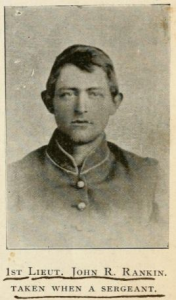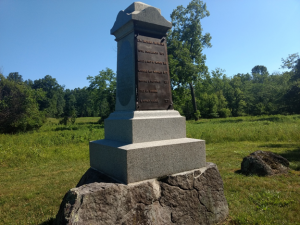John Rankin, Bravery, and Gettysburg
ECW welcomes back guest author Jon Tracey
John Rankin was an average man by most standards. Though an accomplished printer, newspaper editor, and foreign language proofreader for the Government Printing Office postwar, he defined his life less by those successes than one might expect.[1] Instead, he valued three years of his life over all the other decades combined – his service in the American Civil War. During the conflict, he rose from serving as a private to being commissioned as First Lieutenant and commanding his company. His service, and more importantly the way he wrote about and remembered his service in honest recollections afterwards, reveals a great deal about how many Union veterans valued and thought of their service in the post-war years.

John Robert Rankin was born to Melissa and Orville Rankins (the name may have changed at some point, or is at least misspelled in period documents) in Greencastle, Putnam County, Indiana on January 20, 1843.[2] By virtue of his father’s position as a founder of DePauw University along with an aptitude for learning, John was able to secure a position with the local printing office. By 1860 the 17-year-old Rankin was listed as a printer in the census, a profession requiring skill and offering some respect.[3] In 1861, he enlisted in the 27th Indiana Infantry.[4] His obituary recorded that an act of valor at Antietam earned him a promotion to sergeant, mentioning that he was “the only surviving member of his company after the famous charge across the cornfield.” [5] However, his postwar writings about the battle focus more on his fear than on any act of heroism on his part.
At the Battle of Gettysburg on July 3, the 27th Indiana, partnered with the 2nd Massachusetts Infantry, was given one of the most controversial orders of the battle. Confederates held positions on Culp’s Hill on the other side of a meadow from the two veteran regiments. Their brigade was given orders to advance and attack the enemy, and only those two regiments could fit in the meadow; they had no other support. During this chaotic attack and retreat, the two regiments apparently lost sight of each other due to a delay in the 27th starting off, leading to much conflict and debate between veterans later.[6] By the time the 27th reached the midpoint of the meadow they were in the open opposing nearly three times their number behind rocks, fences, and trees along the hillside. The men from Indiana tried to hold on, but after a few short minutes were forced to retreat back to their lines. During this futile charge, Rankin fell to the ground with a grievous wound. The 27th entered the battle with 339 men and lost 16 killed and 139 wounded, 18 of whom died of their wounds. This was a total of 41% casualties almost entirely over the course of twenty minutes.[7]
As the armies left Gettysburg, Rankin had to stay behind. His record noted that he was wounded “severely in the upper part of left thigh.”[8] His road to recovery was long. He spent July in an overcrowded field hospital near the battlefield. Soon after he was transferred to a larger hospital in York, Pennsylvania. Following treatment there, he spent months recovering at a convalescent camp in Baltimore.[9] He did not return to the 27th until December of 1863, five months after his wounding. By then the regiment had been transferred to the western theatre of the war and continued to fight at bloody battles such as Lookout Mountain. That winter, Sergeant Rankin must have continued to impress. As the army prepared for a new campaign, he was promoted to First Lieutenant of Company A on April 19th, 1864.[10] Remarkably, he even came to command the company in July and August 1864, leading the same company he had joined as a private years before.[11] On November 4th, 1864, Rankin’s three-year term of enlistment had run out. He chose not to reenlist, and headed home.

However, the most important facets of Rankin’s life were not the brief biological information above, but rather the way he chose to write about it. His unpublished manuscript, “What I Thought at Antietam” is a touching and brutally honest representation of how he remembered combat and his service. He recorded his fear as his regiment approached the battlefield, recalling that he thought, “How much would I give to be away from here?…What keeps me here in my place? Not honor, but reputation. If I could sneak away I would be willing to try to settle the matter with conscience… the absence of one musket will not make any difference in the general result.”[12] He discussed the battle every soldier fought between courage and cowardice. He remained in formation and fought, yet still believed himself unworthy. He recalled looking around and seeing that his comrades stood bravely, with bullet marks in their clothes, facing doom. He wrote, “My regret is that I am not more worthy to be numbered with them. To all appearances not one of them has faltered, while locked in my own breast is the annoying secret that at the opening of the battle I did not fully withstand the terrible temptation.”[13] He did not portray himself as a hero here – far from it. Instead, he wanted to honestly portray his experience. He painted his comrades as brave, and merely recorded his inner struggle about courage. Perhaps he overcame his fear and nervousness and his memoir was too critical of himself, or perhaps he felt that he did not deserve the promotion after Antietam, and his later memoir was his profession of guilt.
In the decades after the war, the controversial assault on Culp’s Hill was often discussed and criticized. Specifically, many members of the 2nd Massachusetts began writing histories that placed blame for the failure solely on the shoulders of the 27th Indiana. Rankin refused to stand for this. In a letter to a 2nd Massachusetts officer reprinted in the 27th’s regimental history, Rankin recorded his outrage bluntly, having read what he found to be a biased and faulty account. “I am at a loss as to how to proceed to reply,” he wrote, “for I am surprised beyond measure that anything should be written derogatory to the fame of the Twenty-Seventh Indiana… no better or more reliable regiment existed in the service.”[14] He faced these accusations headfirst publicly, penning many articles for the National Tribune, a newspaper dedicated to sharing stories of Union veterans. Frustrated by the Massachusetts Adjutant General report that slandered his unit, Rankin stated these “left-handed complements” were “founded on misstatements.”[15] He found himself in a war of words, with several articles written back and forth between members of the two warring regiments for months. He consulted with other veterans, read reports, and concluded that if the criticism had been fair, “The 27th Ind. Would have meekly borne all that had been said, but the statement being at variance with the facts, we protest against it.”[16] Though he painted a picture of the bravery of the 27th, honesty and truth ranked higher to him than glory. Historian James Marten noted this trend in the writing of other veterans of the war, stating they had an “earnest desire to influence the way that their histories were presented to students and the general public,” and Rankin fits this description.[17]
John Rankin, like many Union veterans, was immensely proud of his service. His writings after the war about the battles of Antietam and Gettysburg offer different insight into the mindset of a common soldier. When writing about Antietam, Rankin was deeply personal and emotional. When writing about Gettysburg, Rankin focused on making sure the truth of his service, as he understood it, was represented. When taken together, they show that he was not merely trying to win glory at Gettysburg, but wished to truthfully recall combat, whether it represented his internal fear or rebuked false accusations of cowardice. His writings and steadfast recordings of what his unit did show that Rankin, in a fashion similar to other veterans, found their service an important moment in their life and wanted their time in the army to be remembered positively, bravely, but most of all honestly.
Jon Tracey holds a BA in History from Gettysburg College and is currently pursuing a MA in Public History and Certificate in Cultural Resource Management from West Virginia University. He has worked as a park ranger for three seasons at Gettysburg National Military Park, and previously worked at Appomattox Court House National Historic Park, Fredericksburg & Spotsylvania National Military Park, and Eisenhower National Historic Park. His primary focuses are historical memory, veterans of the war, and Camp Letterman.
[1] “John R. Rankin is Dead at Home in Washington: Civil War Veteran and Former Newspaper Man, Well Known Here, Succumbs Suddenly,” The Indianapolis Star, October 16, 1910.
[2] Though spelled “Rankins” in some documents like the 1860 census, most paperwork, especially after the Civil War, lists it as “Rankin.”
[3] “John R. Rankin is Dead at Home in Washington: Civil War Veteran and Former Newspaper Man, Well Known Here, Succumbs Suddenly,” The Indianapolis Star, October 16, 1910 and1860 United States Federal Census, 2nd Ward, Town of Greencastle, Putnam County, Indiana, Page 55 (Provo, UT: Ancestry.com Operations, Inc. 2009)
[4] Travis W. Busey and John W. Busey, Union Casualties at Gettysburg: A Comprehensive Record (McFarland & Co.: Jefferson, 2011), 73.
[5] “John R. Rankin is Dead at Home in Washington: Civil War Veteran and Former Newspaper Man, Well Known Here, Succumbs Suddenly,” The Indianapolis Star, October 16, 1910.
[6] Harry W. Pfanz, Gettysburg: Culp’s Hill & Cemetery Hill (University of North Carolina Press: Chapel Hill, 1993), 340-345, 350.
[7] Edmund Randolph Brown, The Twenty-Seventh Indiana Volunteer Infantry in the War of the Rebellion 1861 to 1865 (Monticello, Indiana, 1899), 406, 635. Busey and Busey, 1238.
[8] Busey and Busey, 73.
[9] Ibid,.
[10] Busey and Busey, 73.
[11] “Lieut John Robert Rankin,” Find A Grave, December 2004, Accessed February 2020. https://www.findagrave.com/memorial/10198749/john-robert-rankin.
[12] John Rankin, “What I Thought at Antietam.” pp. 1, 8-10, Benjamin Wilson Smith Papers, pt. 2, Indiana Historical Society, reprinted in “What I Thought at Antietam,” by James. J. and Patience P. Barnes in Civil War Times, September 2006, 19.
[13] Ibid, 54.
[14] Brown, 401.
[15] John Rankin, “Lieut. Rankin Says the 27th Ind. Did Not Join the Right of the 2nd Mass. In That Fight” in Fighting Them Over: How the Veterans Remembered Gettysburg in the Pages of The National Tribune, edited by Richard A. Sauers (Butternut and Blue, 1998), 378-379.
[16] John Rankin, “Lieut. Rankin Again Explains the Positions of the 2d Mass and 27th Ind. On That Field” in Fighting Them Over: How the Veterans Remembered Gettysburg in the Pages of The National Tribune, edited by Richard A. Sauers (Butternut and Blue, 1998), 385-386.
[17] James Marten, Sing Not War: The Lives of Union and Confederate Veterans in Gilded Age America (Chapel Hill: The University of North Carolina Press, 2014) 277.
What an amazing testimony. So many lessons can be pulled from Rankin’s experiences and honest feelings. Thank you for sharing!
Thanks for reading! Rankin’s writings, especially “What I saw at Antietam” are shockingly honest.